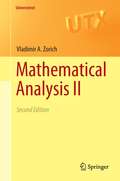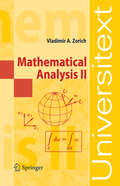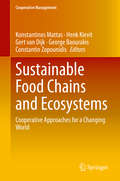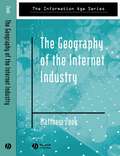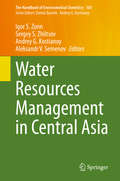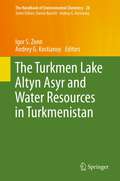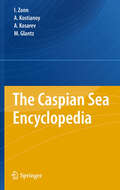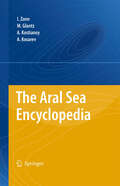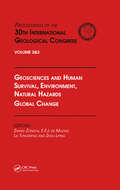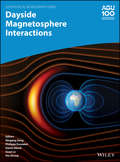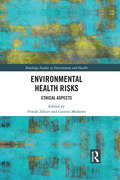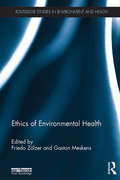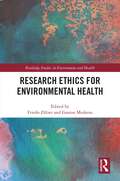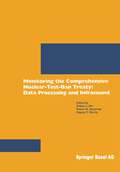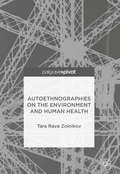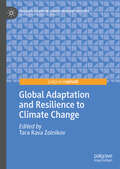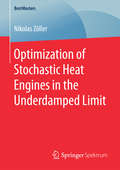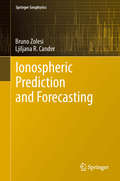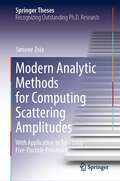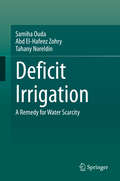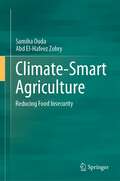- Table View
- List View
Mathematical Analysis II (Universitext)
by V. A. ZorichThis second English edition of a very popular two-volume work presents a thorough first course in analysis, leading from real numbers to such advanced topics as differential forms on manifolds; asymptotic methods; Fourier, Laplace, and Legendre transforms; elliptic functions; and distributions. Especially notable in this course are the clearly expressed orientation toward the natural sciences and the informal exploration of the essence and the roots of the basic concepts and theorems of calculus. Clarity of exposition is matched by a wealth of instructive exercises, problems, and fresh applications to areas seldom touched on in textbooks on real analysis.The main difference between the second and first English editions is the addition of a series of appendices to each volume. There are six of them in the first volume and five in the second. The subjects of these appendices are diverse. They are meant to be useful to both students (in mathematics and physics) and teachers, who may be motivated by different goals. Some of the appendices are surveys, both prospective and retrospective. The final survey establishes important conceptual connections between analysis and other parts of mathematics. This second volume presents classical analysis in its current form as part of a unified mathematics. It shows how analysis interacts with other modern fields of mathematics such as algebra, differential geometry, differential equations, complex analysis, and functional analysis. This book provides a firm foundation for advanced work in any of these directions.
Mathematical Analysis II (Universitext)
by V. A. ZorichAn entire generation of mathematicians has grown up during the time - tween the appearance of the ?rst edition of this textbook and the publication of the fourth edition, a translation of which is before you. The book is fam- iar to many people, who either attended the lectures on which it is based or studied out of it, and who now teach others in universities all over the world. I am glad that it has become accessible to English-speaking readers. This textbook consists of two parts. It is aimed primarily at university students and teachers specializing in mathematics and natural sciences, and at all those who wish to see both the rigorous mathematical theory and examplesofitse?ectiveuseinthesolutionofrealproblemsofnaturalscience. The textbook exposes classical analysis as it is today, as an integral part of Mathematics in its interrelations with other modern mathematical courses such as algebra, di?erential geometry, di?erential equations, complex and functional analysis.
Sustainable Food Chains and Ecosystems: Cooperative Approaches for a Changing World (Cooperative Management)
by Constantin Zopounidis George Baourakis Gert Van Dijk Konstantinos Mattas Henk KievitUnarguably, preserving the ecosystem, securing sustainability and understanding the dynamics of agro-food chains have all become vital policy objectives with several interlinked dimensions. The main objectives of this book are to draw the attention of researchers, policymakers and businesspeople to the relation between agro-food chains and the ecosystem, and to demonstrate the importance of building resilient agro-food chains that take into account climate change and environmental challenges. Agro-food chains as they function today can serve as powerful tools for promoting sustainable forms of agriculture, consumption and production that are embedded in a viable ecosystem. The book addresses a range of environmental, methodological and societal issues from a transaction perspective, while also providing extensive background information on the topic, and outlining future applications and research directions.
The Geography of the Internet Industry: Venture Capital, Dot-coms, and Local Knowledge (Information Age Series)
by Matthew ZookThis groundbreaking book analyses the geography of the commercial Internet industry. It presents the first accurate map of Internet domains in the world, by country, by region, by city, and for the United States, by neighborhood. Demonstrates the extraordinary spatial concentration of the Internetindustry. Explains the geographic features of the high tech venture capital behind the Internet economy. Demonstrates how venture capitalists' abilities to create and use tacit knowledge contributes to the clustering of the internet industry Draws on in-depth interviews and field work in San Francisco Bay Area and New York City.
Water Resources Management in Central Asia (The Handbook of Environmental Chemistry #105)
by Igor S. Zonn Sergey S. Zhiltsov Andrey G. Kostianoy Aleksandr V. SemenovThis book reviews the current status of water resources management in Central Asian countries, and outlines the history, policies and cross-border cooperation regarding water resources management in the region. Particular attention is paid to the evolution of water resources management in Central Asia, past and future water transfer projects, specific problems concerning water use and pollution, and national approaches to water management in Kazakhstan, Kyrgyzstan and Tajikistan, as well as to related conflicts between the Central Asian countries. Together with the companion volumes on Water Resources in Central Asia: International Context and Water Bodies and Climate Change in Central Asia, it offers a valuable source of information for a broad readership, from students and scientists interested in the environmental sciences, to policymakers and practitioners working in the fields of water resources policy and management, international relations, and environmental issues.
The Turkmen Lake Altyn Asyr and Water Resources in Turkmenistan (The Handbook of Environmental Chemistry #28)
by Igor S. Zonn Andrey G. KostianoyThis book offers a concise description of the environment and water resources in Turkmenistan. The focus is on the water bodies of Turkmenistan – the Caspian Sea, Kara-Bogaz-Gol Bay, Sarykamysh Lake, Amu Darya River, and the Karakum Canal. Respected experts from six different countries cover the landscape-geographical features, the Karakum Desert, biodiversity (especially of birds and fishes) and ecosystems, as well as regional climate change. Special attention is paid to the Altyn Asyr Lake water reclamation project, to the morphometric characteristics of the Karashor Depression, and to the four-year-long satellite monitoring of the construction area in the vicinity of the Karashor Depression. The information presented is based on observational data and scientific literature, mainly published in Russian. This is the first English book on the Altyn Asyr Project. It addresses specialists working in various fields of environmental problems and ecology, water resources and management, land reclamation and agriculture, regional climate change, and international cooperation in the water sector in Turkmenistan and Central Asia.
The Caspian Sea Encyclopedia (Encyclopedia of Seas)
by Igor S. Zonn Aleksey N Kosarev Michael Glantz Andrey G. Kostianoy“The Caspian Sea Encyclopedia” is the second one in the new series of encyclo- dias about the seas of the former Soviet Union published by Springer-Verlag. The ?rst volume – “The Aral Sea Encyclopedia” was published by Springer in 2009. The series will be continued by “The Black Sea Encyclopedia” in 2010. Today the Caspian Sea is known to readers thanks to its oil and gas resources, sturgeon and caviar, signi?cant sea-level variations, socio-economic and political problems. The Caucasus and Central Asia (http://eurodialogue. org/?les/fckeditor_?les/Caspian-s- map2. png) vii viii Introduction For more than 250 years the Caspian Sea was shared by two states: Russia (the Soviet Union) and Persia (Iran). After the disintegration of the USSR in 1992, the new independent states of Azerbaijan, Turkmenistan and Kazakhstan have radically changed the political and economic situation in the region. In addition to Russia and Iran, who had determined the situation on the Caspian for a long period, Azerbaijan, Turkmenistan and Kazakhstan are now interested parties, beginning a new stage in the historical development of the Caspian region. This increase in the number of the Caspian legal entities from two to ?ve has given rise to a whole tangle of geopolitical, economic, international legal, ethnic and environmental problems, each of which demands its own approach and settlement mechanism.
The Aral Sea Encyclopedia (Encyclopedia of Seas)
by Igor S. Zonn M. Glantz Aleksey N. Kosarev Andrey G. KostianoyThe ‘‘Aral Sea Encyclopedia’’ is the first one in the new series of encyclopedias about the seas of the former Soviet Union. Preparing it we faced certain difficulties. The thing is that this encyclopedia is a monument to the sea that is disappearing during our lifetime. The world community considers the situation with the Aral Sea and all changes that occurred in its whereabouts in the recent decades as one of the most serious, if not disastrous anthropogenic environmental crises of the 20th century. Before 1960, this was a water-abundant sea-lake that was fourth among world lakes after the Caspian Sea (USSR, Iran), the Great Lakes (USA, Canada) and Victoria Lake (Africa). This was a real ‘‘pearl’’ among the sands of the largest deserts, the Karakums and the Kyzylkums. Navigation between the sea ports Muinak and Aralsk and fisheries famous for the Aral breams, barbells, sturgeons, shemaya, and others were developed here. One could find beautiful recreational zones and beaches here. The deltas of the Amudarya, the major river of Central Asia, and the Syrdarya bringing their waters into the Aral Sea were famous for their biodiversity, fishery, muskrat rearing, reed prod- tion. The local population found occupations related to the water infrastructure.
Geosciences and Human Survival, Environment, Natural Hazards, Global Change: Proceedings of the 30th International Geological Congress, Volume 2 & 3
by Zhang Zonghu E. F. J. De Mulder Liu Tungsheng Zhou LipingThe proceedings of the 30th International Geological Congress held in Beijing, China in August 1997. These two volumes focuses on geosciences and human survival, environment, natural hazards and global changes. They aim to present a view of contemporary geology.
Dayside Magnetosphere Interactions (Geophysical Monograph Series #249)
by Quigang Zong Philippe Escoubet David Sibeck Guan Le Hui ZhangExploring the processes and phenomena of Earth’s dayside magnetosphere Energy and momentum transfer, initially taking place at the dayside magnetopause, is responsible for a variety of phenomenon that we can measure on the ground. Data obtained from observations of Earth’s dayside magnetosphere increases our knowledge of the processes by which solar wind mass, momentum, and energy enter the magnetosphere. Dayside Magnetosphere Interactions outlines the physics and processes of dayside magnetospheric phenomena, the role of solar wind in generating ultra-low frequency waves, and solar wind-magnetosphere-ionosphere coupling. Volume highlights include: Phenomena across different temporal and spatial scales Discussions on dayside aurora, plume dynamics, and related dayside reconnection Results from spacecraft observations, ground-based observations, and simulations Discoveries from the Magnetospheric Multiscale Mission and Van Allen Probes era Exploration of foreshock, bow shock, magnetosheath, magnetopause, and cusps Examination of similar processes occurring around other planets The American Geophysical Union promotes discovery in Earth and space science for the benefit of humanity. Its publications disseminate scientific knowledge and provide resources for researchers, students, and professionals.
Dayside Magnetosphere Interactions (Geophysical Monograph Series #249)
by Qiugang Zong Philippe Escoubet David Sibeck Guan Le Hui ZhangExploring the processes and phenomena of Earth’s dayside magnetosphere Energy and momentum transfer, initially taking place at the dayside magnetopause, is responsible for a variety of phenomenon that we can measure on the ground. Data obtained from observations of Earth’s dayside magnetosphere increases our knowledge of the processes by which solar wind mass, momentum, and energy enter the magnetosphere. Dayside Magnetosphere Interactions outlines the physics and processes of dayside magnetospheric phenomena, the role of solar wind in generating ultra-low frequency waves, and solar wind-magnetosphere-ionosphere coupling. Volume highlights include: Phenomena across different temporal and spatial scales Discussions on dayside aurora, plume dynamics, and related dayside reconnection Results from spacecraft observations, ground-based observations, and simulations Discoveries from the Magnetospheric Multiscale Mission and Van Allen Probes era Exploration of foreshock, bow shock, magnetosheath, magnetopause, and cusps Examination of similar processes occurring around other planets The American Geophysical Union promotes discovery in Earth and space science for the benefit of humanity. Its publications disseminate scientific knowledge and provide resources for researchers, students, and professionals.
Environmental Health Risks: Ethical Aspects (Routledge Studies in Environment and Health)
by Friedo Zölzer Gaston MeskensEnvironmental health involves the assessment and control of environmental factors that can potentially affect human health, such as radiation, toxic chemicals and other hazardous agents. It is less commonly understood that environmental health also requires addressing questions of an ethical nature. Bringing together work from experts across a range of sub-disciplines of environmental health, this collection of essays discusses the ethical implications of environmental health research and its application, presented at the 3rd International Symposium on Ethics of Environmental Health held in August 2016 in the Czech Republic. In doing so, it builds upon the insights and ideas put forward in the first volume of Ethics of Environmental Health, published by Routledge in early 2017. This volume will be of great interest to students and scholars of environmental health, applied ethics, environmental ethics, medical ethics and bioethics, as well as those concerned with public health, environmental studies, toxicology and radiation.
Environmental Health Risks: Ethical Aspects (Routledge Studies in Environment and Health)
by Friedo Zölzer Gaston MeskensEnvironmental health involves the assessment and control of environmental factors that can potentially affect human health, such as radiation, toxic chemicals and other hazardous agents. It is less commonly understood that environmental health also requires addressing questions of an ethical nature. Bringing together work from experts across a range of sub-disciplines of environmental health, this collection of essays discusses the ethical implications of environmental health research and its application, presented at the 3rd International Symposium on Ethics of Environmental Health held in August 2016 in the Czech Republic. In doing so, it builds upon the insights and ideas put forward in the first volume of Ethics of Environmental Health, published by Routledge in early 2017. This volume will be of great interest to students and scholars of environmental health, applied ethics, environmental ethics, medical ethics and bioethics, as well as those concerned with public health, environmental studies, toxicology and radiation.
Ethics of Environmental Health (Routledge Studies in Environment and Health)
by Friedo Zölzer Gaston MeskensEnvironmental health encompasses the assessment and control of those environmental factors that can potentially affect human health, such as radiation, toxic chemicals and other hazardous agents. It is often assumed that the assessment part is just a matter of scientific research, and the control part a matter of implementing standards which unambiguously follow from that research. But it is less commonly understood that environmental health also requires addressing questions of an ethical nature. How can we determine the "acceptable" risk level for the general population or for certain groups? How should we deal with uneven distributions of risks and benefits? How do we communicate about risks with the stakeholders? This multidisciplinary collection brings together a number of leading researchers and scholars in order to generate discussion surrounding these key questions, and to bring the ethical implications of science and technology to the forefront of critical thought. Providing a broad overview of the Ethics of Environmental Health, its philosophical foundations and practical applications, this book offers a significant contribution to ongoing discussions in sustainable development and will be of interest to scholars and practitioners of Environmental Health, urban studies and healthcare.
Research Ethics for Environmental Health (Routledge Studies in Environment and Health)
by Friedo Zölzer Gaston MeskensResearch Ethics for Environmental Health explores the ethical basis of environmental health research and related aspects of risk assessment and control. Environmental health encompasses the assessment and control of those environmental factors that can potentially affect human health, such as radiation, toxic chemicals and other hazardous agents. It is often assumed that the assessment part is just a matter of scientific research, and that control is a matter of implementing standards that unambiguously follow from that research. But it is less commonly understood that environmental health also requires addressing questions of an ethical nature. Coming from multiple disciplines and nine different countries, the contributors to this book critically examine a diverse range of ethical concerns in modern environmental health research. This book will be of great interest to scholars and practitioners of environmental health, as well as researchers in applied ethics, environmental ethics, medical ethics, bioethics and those concerned with chemical and radiation protection.
Research Ethics for Environmental Health (Routledge Studies in Environment and Health)
by Friedo ZölzerResearch Ethics for Environmental Health explores the ethical basis of environmental health research and related aspects of risk assessment and control. Environmental health encompasses the assessment and control of those environmental factors that can potentially affect human health, such as radiation, toxic chemicals and other hazardous agents. It is often assumed that the assessment part is just a matter of scientific research, and that control is a matter of implementing standards that unambiguously follow from that research. But it is less commonly understood that environmental health also requires addressing questions of an ethical nature. Coming from multiple disciplines and nine different countries, the contributors to this book critically examine a diverse range of ethical concerns in modern environmental health research. This book will be of great interest to scholars and practitioners of environmental health, as well as researchers in applied ethics, environmental ethics, medical ethics, bioethics and those concerned with chemical and radiation protection.
Monitoring the Comprehensive Nuclear-Test-Ban Treaty: Data Processing and Infrasound (Pageoph Topical Volumes)
by Zoltan A. Der, Robert H. Shumway and Eugene T. HerrinOn September 10, 1996, The United Nations General Assembly adopted the Copmprehensive Nuclear-Test-Ban Treaty (CTBT), prohibiting nuclear explosions worldwide, in all environments. The treaty calls for a global verification system, including a network of 321 monitoring stations distributed around the globe, a data communications network, an international data center (IDC), and on-site inspections, to verify compliance. This volume presents certain recent research results pertaining on methods used to process data recorded by instruments of the International Monitoring System (IMS) and addressing recording infrasound signals generated by atmospheric explosions. Six papers treating data processing provide an important selection of topics expected to contribute to improving our ability to successfully monitor a CTBT. Five papers concerning infrasound include descriptions of ways in which that important research area can contribute to CTBT monitoring, the automatic processing of infrasound data, and site conditions that serve to improve the quality of infrasound data.
Autoethnographies on the Environment and Human Health
by Tara Rava ZolnikovThis book explores the link between individual lives and significant environmental issues affecting millions of people around the world. Zolnikov offers a novel perspective on the environment and human health through autoethnographic stories. Each chapter includes an overview of an environmental risk factor or issue, such as air quality, accompanied by a reflective personal story. Her experiences were gathered around the world and revolve around immersion into local cultures. Learning about environmental health through this qualitative approach will enable readers to understand how issues in the environment are currently affecting people on an individual basis.
Autoethnographies on the Environment and Human Health
by Tara Rava ZolnikovThis book explores the link between individual lives and significant environmental issues affecting millions of people around the world. Zolnikov offers a novel perspective on the environment and human health through autoethnographic stories. Each chapter includes an overview of an environmental risk factor or issue, such as air quality, accompanied by a reflective personal story. Her experiences were gathered around the world and revolve around immersion into local cultures. Learning about environmental health through this qualitative approach will enable readers to understand how issues in the environment are currently affecting people on an individual basis.
Global Adaptation and Resilience to Climate Change (Palgrave Studies in Climate Resilient Societies)
by Tara Rava ZolnikovThis book explores the link between climate change and resiliency on each continent of the world. It reviews how climate change affects populations, not only through environmental exposures and health outcomes, but how people live their lives. Zolnikov brings together a set of experts to offer a novel perspective on understanding climate change vulnerability alongside adaption measures being implemented. Each chapter includes an overview on how climate change will affect that continent alongside current adaptation, mitigation, and policies that seek to improve population outcomes. As a whole, the book explores why a “one size fits all” approach to promote climate change resiliency does not work; however, a global perspective can facilitate people learning from one another and facing climate change together.
Optimization of Stochastic Heat Engines in the Underdamped Limit (BestMasters)
by Nikolas ZöllerNikolas Zöller examines the working principles and the underlying theoretical foundations of a microscopic heat engine. In particular, he investigates the system’s stochastic dynamics in the underdamped regime which has hardly been studied in the past, but will be experimentally feasible in the near future due to recent technological developments. Emphasis is put on the maximization of the engine’s efficiency at maximum power through optimization of the driving protocol. In addition, possible experimental realizations of a microscopic heat engine are discussed.
Ionospheric Prediction and Forecasting (Springer Geophysics)
by Bruno Zolesi Ljiljana R. CanderThis book describes how to predict and forecast the state of planet Earth’s ionosphere under quiet and disturbed conditions in terms of dynamical processes in the weakly ionized plasma media of the upper atmosphere and their relation to available modern measurements and modelling techniques. It explains the close relationship between the state of the media and the radio wave propagation conditions via this media. The prediction and forecasting algorithms, methods and models are oriented towards providing a practical approach to ionospherically dependent systems design and engineering. Proper understanding of the ionosphere is of fundamental practical importance because it is an essential part of telecommunication and navigation systems that use the ionosphere to function or would function much better in its nonappearance on the Earth and on any planet with an atmosphere.
Modern Analytic Methods for Computing Scattering Amplitudes: With Application to Two-Loop Five-Particle Processes (Springer Theses)
by Simone ZoiaThis work presents some essential techniques that constitute the modern strategy for computing scattering amplitudes. It begins with an introductory chapter to fill the gap between a standard QFT course and the latest developments in the field. The author then tackles the main bottleneck: the computation of the loop Feynman integrals. The most efficient technique for their computation is the method of the differential equations. This is discussed in detail, with a particular focus on the mathematical aspects involved in the derivation of the differential equations and their solution. Ample space is devoted to the special functions arising from the differential equations, to their analytic properties, and to the mathematical techniques which allow us to handle them systematically. The thesis also addresses the application of these techniques to a cutting-edge problem of importance for the physics programme of the Large Hadron Collider: five-particle amplitudes at two-loop order. It presents the first analytic results for complete two-loop five-particle amplitudes, in supersymmetric theories and QCD. The techniques discussed here open the door to precision phenomenology for processes of phenomenological interest, such as three-photon, three-jet, and di-photon + jet production.
Deficit Irrigation: A Remedy for Water Scarcity
by Abd El-Hafeez Zohry Samiha Ouda Tahany NoreldinThis book focuses on proving that deficit irrigation could play an important role in increasing food production in times of water scarcity. Although the application of deficit irrigation can involve loss in crop productivity, it still secures water to be use in cultivating more lands and producing more food. The following questions are discussed and the authors offer solutions to these problems:Will the production, on a national level, resulting from these new added areas compensate yield losses attained by application of deficit irrigation?Is it possible to use deficit irrigation practice to reduce the applied irrigation water to certain crops that have a surplus in their production, and direct this saved water to cultivate new areas with crops have low self-sufficiency ratios? Under climate change in 2030, would deficit irrigation practice have the same role it plays under the current conditions? This book will appeal to students and researchers involved with water scarcity and food security.
Climate-Smart Agriculture: Reducing Food Insecurity
by Abd El-Hafeez Zohry Samiha OudaThis book tackles the main feature of water-smart, soil-smart and crop-smart practices and their integration to sustainably enhance food production. The book includes some insights on the implications of using climate-smart practices in irrigated and rain-fed agriculture, and suggests approaches to eradicate the negative effects of water scarcity, climate variability and climate change. The book reviews the most important crops resilient to climate variability and their resistance to other biotic and abiotic stresses, and contains the existing practices in Egypt that achieved the three pillars of climate-smart agriculture
